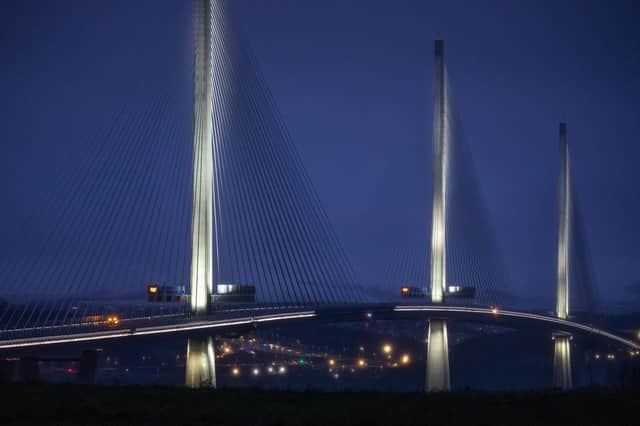Lab tests for measures to stop ice falling from Queensferry Crossing


The revelation follows a four-hour closure of the crossing on Friday after newly-installed sensors detected ice for the first time and it was seen falling from the towers.
The Scottish Government’s Transport Scotland agency said options that may be tested included “cable sheath surface modifications” to retain and control ice, a mechanical vibration system, ultrasonic de-icing systems and robotics.
Advertisement
Hide AdAdvertisement
Hide AdHowever, it said using heated wires to prevent ice build-up, or “accretion”, would pose “significant maintenance challenges”.


The agency said mock-up laboratory and on-site trials of the other options were being considered.
A spokesperson told The Scotsman: “This will require the use or construction of a facility which can replicate the climatic conditions required for ice to form so that each developing option can be confirmed to actually work in the particular circumstances found on the crossing.”
Ice accretion on the bridge only occurs when temperatures of around 0C are accompanied by particular levels of relative humidity, specific wind speeds and wind direction coinciding with the dew point – when air become saturated with water vapour.
Any option found to be viable to tackle this would then be tested for value for money.
It would also be assessed against using the adjacent Forth Road Bridge as a diversion route, which is to be tested on Saturday night when both bridges will be closed from 10pm to 8am on Sunday.
The exercise is to see how long it would take to switch traffic if ice forced the closure of the three-year-old Queensferry Crossing again.
The Forth Road Bridge could not be used on Friday because it was closed for the replacement of expansion joints under its carriageways.
Advertisement
Hide AdAdvertisement
Hide AdDesigners of the Queensferry Crossing had thought ice would be a relatively rare occurrence, but it happened last year when several vehicle windscreens were smashed, and again in February.
The latter incident closed the bridge for two days.
Transport Scotland said its research showed that a perfect solution to tackle the ice threat had not been devised for any other bridges globally.
A spokesperson said: “A review of measures on other bridges has been undertaken to explore the options available for the Queensferry Crossing.
"The review indicates that whilst many methods of prevention and removal have been studied, tested and deployed, no single method or technology has been found to be completely successful in mitigating the problem or removing ice build-up.
"As a completely successful prevention or removal methodology has not been identified, currently most operators close the bridge and wait for the ice to fall.”
The options are being considered by bridge operator BEAR Scotland “and the most appropriate will be considered for further investigations, testing and development.”
The spokesperson added: “Other factors such as the associated cost, success of the Forth Road Bridge as a diversion route, frequency of ice events and safety of road users will be considered as part of the decision-making process prior to any installation of a viable option for ice accretion prevention.”
However, the option of using heated wires appears to have been discounted.
Advertisement
Hide AdAdvertisement
Hide AdThe spokesperson said: “The efficiency of such a system at this scale is unknown and the maintenance challenges to keep a complex heating system working with no reasonable access are significant.
"Trials of targeted heating systems have been undertaken by other bridge operators, but none have proven sufficiently efficient or reliable to warrant a full deployment.”
Traffic will be diverted via the Kincardine Bridge during the bridges’ closure on Saturday, adding up to 36 miles and 40 minutes to journeys.
The west footpath on the Forth Road Bridge will remain open to cyclists and pedestrians.
A further trial when traffic will be diverted onto the Forth Road Bridge will be carried out in the next few months.
Neil Greig, policy and research director of the IAM RoadSmart motoring group, said: “We welcome the commitment to open the Forth Road Bridge as an alternative route for all traffic.
“That always made perfect sense to us as the best use of the available infrastructure to minimise congestion and delays.
"It is very worrying, however, that the impact of ice accretion on the new bridge seems to be the subject of detailed investigation only now.
Advertisement
Hide AdAdvertisement
Hide Ad"Value for money will be an issue but we would urge the Scottish Government to redouble its efforts to find a solution that guarantees the safety of bridge users and will help restore confidence in this iconic structure.”
The Scottish Conservatives said repeated ice closures would be “catastrophic”.
Mid Scotland and Fife MSP Murdo Fraser said: “I welcome the fact Transport Scotland is looking at alternative measures if the Queensferry Crossing closes again by using the Forth Road Bridge.
"However, I am concerned at this value for money exercise.
"It sounds like they are looking for a cheap option which probably won’t address the problem and could see the bridge close again.
“The Scottish Government need to look at a long-term solution to this problem, such as fitting heated wires to, or cladding, the cables - as engineers have proposed.
"The cost of installing these would be extensive, but it is outweighed by the enormous economic cost of regular bridge closures.
“If the disruption we saw last week is repeated throughout the winter, the impact will be catastrophic.”
A message from the Editor:
Thank you for reading this article.
We're more reliant on your support than ever as the shift in consumer habits brought about by coronavirus impacts our advertisers.
If you haven't already, please consider supporting our trusted, fact-checked journalism by taking out a digital subscription.
Comments
Want to join the conversation? Please or to comment on this article.